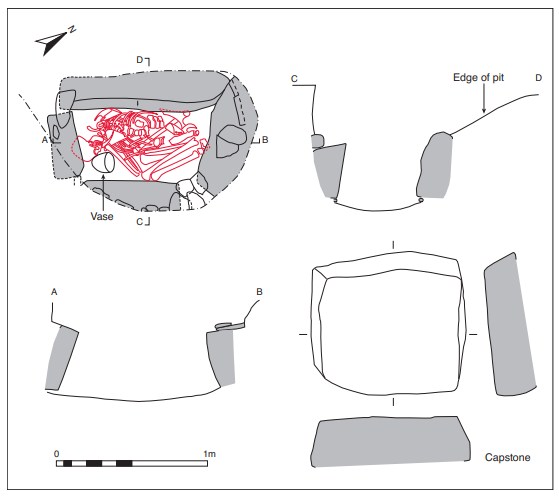County: Westmeath Site name: CLONICKILVANT, CO. WESTMEATH
Sites and Monuments Record No.: SMR WM020-137 Licence number: E1165
Author: MARY CAHILL
Site type: Early Bronze Age graves
Period/Dating: —
ITM: E 652746m, N 753555m
Latitude, Longitude (decimal degrees): 53.529305, -7.204438
Introduction
In January 1980 a short cist containing an inhumation and a vase was discovered during bulldozing on a farm near Killucan, Co. Westmeath. The site was reported to the NMI by Ms Joan Vandeleur, Wardenstown, Co. Westmeath. A rescue excavation was carried out by Mary Cahill, assisted by Kieran Campbell, and the human remains were examined by Professor C.A. Erskine. Two other burials had previously been found in this townland, in the adjacent field.
Location (Fig. 3.182)
The site was in the townland of Clonickilvant, east Co. Westmeath,325 4km north-west of Killucan town at an altitude of approximately 100m above sea level. The cist was just 500m north of an early Bronze Age pit burial excavated by Étienne Rynne in 1964 (Vandeleur 1963–6).

A third burial in the form of a pit is reported to have been found in the vicinity of the latter, but was destroyed upon discovery (Waddell 1990, 149).
Description of site
The cist, which lay approximately 0.3m below ground level, was trapezoidal in plan, with its long axis aligned north/south. It measured 0.95m long by 0.55m wide by 0.48m high (Fig. 3.183). The chamber was constructed of four main slabs set on edge, each one forming a cist wall. These slabs were large in proportion, the maximum thickness being 0.3m. The end slabs inclined inwards slightly and, in some cases (at the north-eastern and south-western corners) a number of small flat slabs had been laid flat over the sides to ensure that the capstone would be level. A number of packing stones were also visible around the outside of the cist . The floor of the cist was not paved but was formed of earth with a few small stone inclusions. A large rectangular capstone measuring 0.9m long by 0.82m wide by 0.3m thick sealed the cist.
The cist contained a crouched inhumation of a young adult male (1980:43) accompanied by a vase of anomalous type (Ó Ríordáin and Waddell 1993, 141) and a mussel shell (1980:134). The skeleton lay with the head to the south, facing east. The legs were tightly flexed and the right arm also, but the left arm bones were not visible. The burial fitted tightly into the cist, with the feet apparently placed flat against the northern end stone. The vessel had been placed immediately east of the skull, and the shell was found between the skull and the vessel.
Anomalous vase, 1980:42 (Fig. 3.184)
The vase is in fragmentary condition. Approximately three-quarters of the vessel has been reconstructed.

The base had almost completely disintegrated. Most of the external surface is covered in a calcite deposit obscuring much of the detail of the decoration. The vessel has a very simple rounded profile with no shoulder or neck. The rim has a slight bevel, which is undecorated. The main decorative motif is a series of interlocking raised V-shapes in two rows—one descending from the rim, the other rising from the base. The arms of the Vs have some shallow toothed impressions. On some other parts of the body of the vessel, in the spaces between the Vs there are some toothed impressions in the form of arcs. Ó Ríordáin and Waddell (1993, 140, 289) describe the vessel as anomalous or unclassifiable.

Dimensions: max. H 12cm; ext. D rim 12.5–13cm; T of body 0.9cm; W of bevelled rim 0.7–0.8cm.
Comment
The human remains from this site have not been dated. At least three burials, two pits and a cist have been recorded from this townland, but as there is quite a distance between them they do not appear to be part of the same cemetery. Within the townland of Clonickilvant there are two small lakes (now drained), White Lough and Black Lough, either of which might have been the source of the mussel shell found in the grave. The presence of mussel shells has been noted at a number of other sites in this volume, e.g. Kinard, Co. Mayo, all of which are within a short distance of a fresh water source. The significance of the shell is not understood. It may be a symbolic representation of a last meal or a source of sustenance for the deceased on his journey to the next world.
HUMAN REMAINS
C.A. ERSKINE
1980:43—complete young adult male skeleton, well preserved; 170–172cm.
Skull: almost complete; parts of occipital and parietal bones missing with some erosion.
Teeth: maxillary teeth do not show wear; mandibular with slight wear only of incisors; dentition complete.
Mandible large and strongly marked.
Vertebrae: all present, some show slight damage.
Ribs: complete. Body of sternum in two pieces (probably not fused).
Limbs: arm: all bones present in both upper limbs; upper part of the left ulna; lower limb: (left femur removed). Right femur large and well marked; tibia and fibula well preserved. Right fibula has PM breaks; left tibia in two pieces. Erosion of left fibula.
All carpal and tarsal bones present and complete.
325. Parish of Rathconnell, barony of Moyashel and Magheradernon. WM020-137——. NGR 252807 253533. The pit burial investigated in 1964 is WM020-077——.